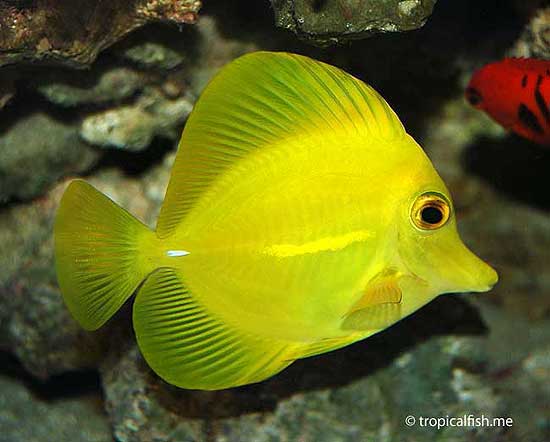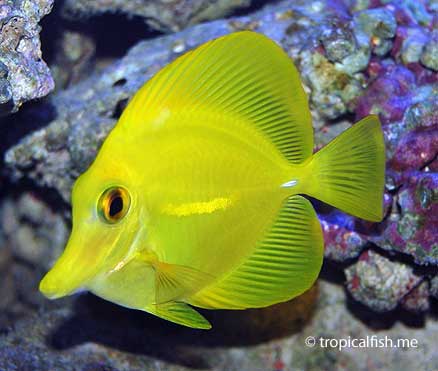|
|
Yellow Tang

The
Yellow Tang is also known as the Yellow Hawaiian Tang, Yellow Sailfin Tang, and
the Yellow Surgeonfish. They come from the Central and South Pacific, including
Hawaii, Indonesia and the Great Barrier Reef. They are a major export from
Hawaii and this is the preferred source of quality specimens. Unfortunately this
has also resulted in substantial decline of wild populations and collection
efforts have damaged the
coral reefs in Hawaii. As
a result of the environmental damage caused by the collection of yellow tangs,
we don't recommend their purchase, but we note that they are among the
most popular choices for saltwater aquariums. Yellow tangs are a solid yellow color with a protruding snout. They are a
surgeonfish, so named for the two "surgeon's scalpel" spines that can
pierce at intruders at their caudal peduncle.
Yellow Tangs should have an aquarium of about 100 gallons for adequate hiding
spaces and swimming room. They are best suited for a fish only tank. They enjoy
a rich coral environment, but will eat invertebrates. Either keep a single fish
or a group of at least 6 to spread out aggression. They are active, curious
aquarium inhabitants. They pay attention to what is going on in and outside the
aquarium. Yellow Tangs react quickly to inappropriate pH levels.

Yellow Tangs are omnivorous in aquarium life, but vegetable matter should be
the mainstay of their diet. They are always hungry. They will eat algae, peas,
lettuce, spinach , dried seaweed (nori), spirulina flakes, as well
as frozen brine shrimp and flake foods. They like crustaceans and meaty foods can also be provided. They
should be fed small amounts several times a day. Yellow Tangs will help keep
natural algae in the tank under control.
There is no visible difference between males and females. Yellow Tangs spawn
in pairs and in groups. They are egg-scatterers and have not been bred in
captivity, which is the main reason their populations are being depleted in
Hawaii.
Due to their scalpel type spines, Tangs can easily become badly entangled in
nets. It is best to catch them in plastic bags or containers to prevent injuries
to the fish. Yellow tangs are susceptible to ich, velvet, black spot, flatworm
black dot and head & lateral line erosion. When choosing a yellow tang, look
for an active, brightly colored specimen that is checking you out.
| Scientific Name: |
Zebrasoma flavescens |
| Family: |
Acanthuridae |
| Care: |
Normal |
| Temperature: |
24 - 28 C; 75 - 82 F |
| pH: |
8.1 - 8.4 |
| dH: |
8 - 12 |
| Specific Gravity: |
1.018 - 1.025 |
| Size: |
20 cm; 8 inches |
| Breeding: |
Egg Layer |
| Life Span: |
years |
| Crustacean Safe: |
No |
| Coral Safe: |
Yes |
|
Compatibility:
|
|
Zebrasoma flavescens do best when kept singly, but
in the wild they feed on the coral reefs in large
ups. They may act aggressively towards other species of tangs,
so they are best kept as the only tang species in
the tank. A Regal Tang may do well with it. Suitable tank mates include Blennies, Angelfish, Damsels, Wrasses and Rabbitfish.
|
|